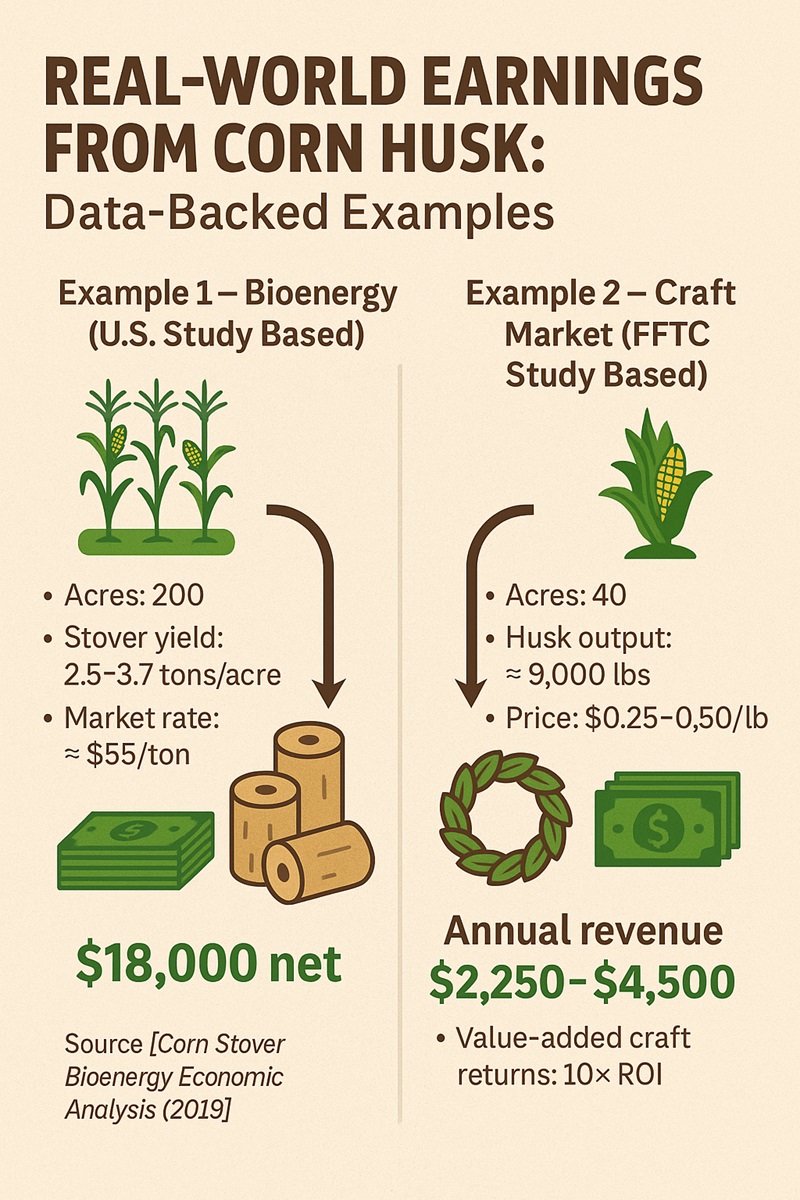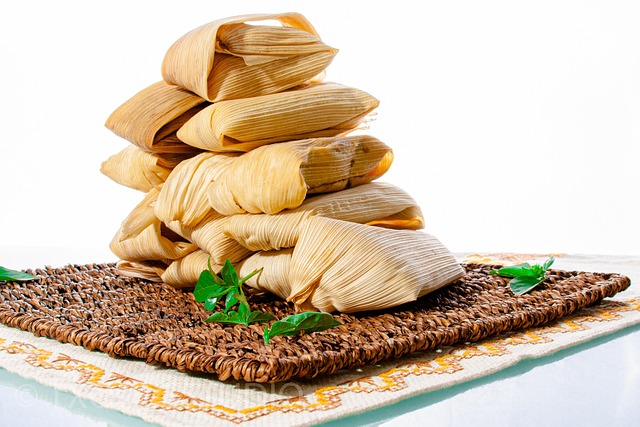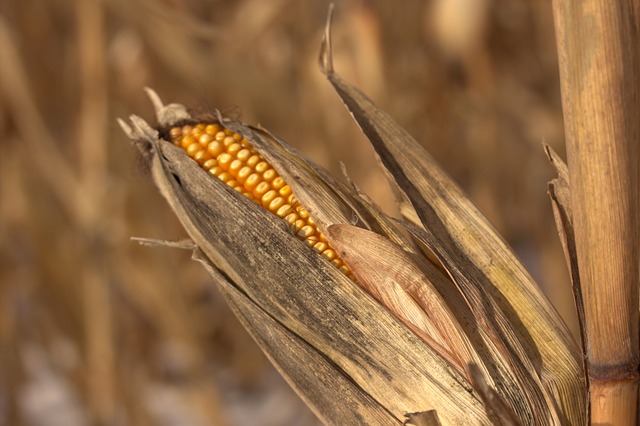Corn husks are often treated as waste—but they’re far more valuable than many farmers realize. With growing demand in culinary markets, crafts, gardening, and renewable energy, corn husk can become a predictable new revenue stream. Whether dried, shredded, or processed alongside corn stover, husks can eliminate waste costs and unlock high-demand sustainable markets.
This editorial guide explains the smartest ways farmers can monetize corn husk—plus real-world numbers showing what farmers actually earn.
Quick Answer: What Is Corn Husk?
A corn husk is the leafy outer covering of an ear of corn. It protects the kernels during growth and is typically removed before cooking. While often discarded, corn husks can be used for:
- Cooking (tamales, steaming, grilling)
- Livestock feed
- Organic mulch and compost
- Crafts and natural fiber goods
- Eco-friendly packaging
- Biomass fuel
Why Corn Husk Waste Is a Missed Opportunity
Every harvest season, U.S. cornfields generate thousands of pounds of husk that end up burned, shredded in fields, or left to decompose. But strong demand exists in multiple industries:
- Restaurants buy food-grade husks for tamales and steaming fish.
- Garden centers want low-cost organic mulch.
- Craft industries use husks for natural décor and handmade paper.
- Biomass processors buy corn stover—including husk—for renewable fuel.
With minimal processing, husk can move from “waste product” to a profitable farm asset.
How to Clean, Dry & Store Corn Husk (Preparation 101)
Cleaning and drying corn husks is a simple job. The goal is to keep the husks clean, dry, and safe from mold. When farmers handle husks with care, the husks keep their color and stay useful for a long time.
Cleaning
Cleaning comes first. Farmers shake off dirt, loose silk, and small bits from the field. Any husk with insect damage or dark marks gets thrown away. For food use, the husks get a quick rinse with clean water and a gentle pat-dry. It is a light clean, like brushing dust off fresh produce.
Drying
Drying is the key step. In many places, farmers still use the sun. They spread the husks on clean tarps and let warm air dry them for one or two days. When the weather changes a lot or farmers have a big batch, they switch to air-drying racks in a barn. The racks help with airflow and keep the husks flat, which is helpful for crafts. For food-grade husks, steady heat works best. Many farmers use low-heat dryers set under 120°F. This slow method keeps the husks pale, flat, and evenly dried.
All drying methods aim for the same goal: bring the moisture below 12%. At this level, the husks stay safe and ready for long-term storage.
Storage
Storage is the final step. Husks last longer in cotton or jute bags kept in cool, dry rooms. Farmers who sell to restaurants use sealed plastic totes or lined boxes to keep the husks clean. Sunlight can fade the color, so the husks should stay out of direct light. When stored well, dried husks can stay fresh for a year or more.
Corn Husk Quality Grades (What Buyers Pay For)
Just like hay, timber, or fresh produce, corn husk is priced according to quality. Buyers look for very specific traits, and understanding these expectations can make the difference between earning a few cents per pound and several dollars.
Food-grade
At the top of the market is food-grade husk, the kind used for tamales or for wrapping fish before steaming or grilling. These husks are usually light in color, unbroken, and dried completely flat so they remain pliable when rehydrated. Restaurants and food suppliers also want assurance that the husks haven’t been exposed to chemicals or pesticide drift, which is why careful handling and clean storage matter so much.
Craft-grade
Craft-grade husks sit comfortably in the middle tier. Artists and DIY makers aren’t looking for perfection—slight color variations or gentle curling at the edges are perfectly acceptable. What matters is that the husks are fully dried and still have enough structure to be shaped into dolls, floral arrangements, braided ropes, or handmade paper. For many small farms, this is the easiest grade to produce because it doesn’t require immaculate uniformity.
Fiber or mulch grade
The lowest grade, often referred to as fiber or mulch grade, absorbs everything else: mixed sizes, broken pieces, shredded fiber, and any husk that doesn’t meet the cosmetic standards of higher-value buyers. This grade is still highly marketable. Garden centers use it as mulch or compost material, while biomass processors incorporate it into stover-based fuel products.
Sorting husks into these three categories does require a bit of extra labor—but it almost always pays for itself. By separating premium-quality husks instead of selling everything as bulk fiber, farmers routinely double or even triple their returns.
Corn Husk Market Prices (2024–2025 Guide)
Corn husk prices in the U.S. are easier to follow today. Many restaurants, craft makers, and biomass companies now buy husks as part of their regular supply needs. Food-grade husks cost the most. They usually sell for three to seven dollars per pound. Wholesalers and restaurants pay less—about eighty cents to two and a half dollars per pound—but they buy more and place repeat orders. Very wide or premium husks can sell for up to ten dollars per pound, especially during holidays when tamale demand rises.
Craft-grade husks fall in the middle of the price range. Bulk dried husks for crafts cost twenty-five to fifty cents per pound. Curated bundles cost much more. Many small producers pack ten to twenty husks into small bundles that sell for eight to twenty dollars. This lets farmers earn more without major extra work.
Fiber-grade and shredded husks for mulch follow a different system. Garden centers buy this material by volume, not weight. Prices range from thirty to sixty dollars per cubic yard. Biomass processors buy stover—which includes husks, leaves, and stalks—by the ton. They usually pay forty to seventy dollars at the farm gate, depending on moisture, distance, and contract terms. Compost-ready husks sit in between. Bagged blends with dried husk often sell for four to eight dollars per bag.
Prices change a little from place to place, but the pattern is clear: corn husk has become a stable side market with options for farms of any size.

Top Ways Farmers Can Turn Corn Husk Into Profit
Below are the strongest markets for monetizing husk on U.S. farms.
Turn Corn Husk Into Low-Cost Livestock Feed
Corn husk contains digestible fiber and adds bulk to ruminant diets—especially valuable during winter feed shortages.
Why It Works
- Extends feed supply
- Reduces hay expenses
- Provides roughage for cattle, goats, and sheep
How to Prepare
- Dry thoroughly to prevent mold
- Shred for easier chewing and digestion
- Mix with protein-rich feed
Sell Corn Husk as Organic Mulch
Gardeners and landscapers want natural, chemical-free mulch.
Why It Sells
- Retains moisture
- Suppresses weeds
- Breaks down slowly
- Adds organic matter to soil
Farmers can shred husks, dry them, and package them into bags or wholesale bales.
Convert Corn Husk Into Compost
Corn husk is rich in carbon and works well in compost blends.
How Farmers Monetize It
- Mix husk with manure or green waste
- Create windrow piles
- Screen and bag finished compost
- Sell to nurseries, garden centers, or landscapers
Supply Food-Grade Corn Husk to Restaurants & Food Producers
A high-margin, fast-growing market driven by Mexican and Southwestern cuisine.
What Is Food-Grade Corn Husk?
Corn husk that is cleaned, dried, sorted, and handled safely for cooking.

Culinary Uses
Tamales
The #1 use for food-grade husk—restaurants buy thousands of pounds yearly.
Steaming Fish & Poultry
Adds mild sweetness and prevents sticking.
Smoked Grilling Wraps
Popular in BBQ restaurants for seafood and ribs.
Stock & Broth Flavoring
Dried husks simmered with soups add aroma and body.
Sell Corn Husk to the Craft & Eco-Packaging Market
Craft-grade husk is widely used for:
- Corn-husk dolls
- Wreaths and floral décor
- Braided rope
- Handmade paper
- Biodegradable packaging filler
This is one of the easiest markets for small farms.
Convert Corn Husk Into Eco-Friendly Packaging Material
As e-commerce expands, sustainable fillers are in demand.
Corn husk fibers:
- Cushion fragile items
- Replace plastic foam
- Are compostable and lightweight
This market is expected to grow as more brands shift away from plastic.
Sell Corn Husk as Biomass Fuel
Bioenergy plants purchase baled stover—including husks—to produce:
- Pellets
- Electricity
- Liquid biofuel
Large farms often earn steady supplemental income through annual contracts.
Environmental Benefits of Reusing Corn Husk
Reusing corn husk isn’t simply a clever way for farmers to earn more income—it’s also a quiet win for the environment. Every pound of husk that’s collected, dried, or repurposed keeps agricultural waste out of burn piles and reduces the need for synthetic materials downstream. Across the Midwest and Southwest, farmers who once viewed husks as a nuisance are now recognizing how these fibers contribute to a cleaner, more circular agricultural system.
Reducing Field Burning
One of the most immediate benefits is the reduction in field burning. Open-field burns release methane and other greenhouse gases that build up quickly across large corn-producing regions. When husks are diverted into feed, crafts, mulch, or biofuel instead of being burned, farms can cut a surprising amount of seasonal emissions with almost no disruption to their workflow.
Natural Alternative to Plastic Packaging
Repurposed husks also have an unexpected role in the fight against plastic waste. As more companies shift toward eco-friendly packaging, corn husk fiber has become a natural substitute for foam fillers and synthetic packing materials that often end up in landfills. It’s lightweight, biodegradable, and requires almost no processing—an easy environmental upgrade for small businesses and local producers.
Mulch and Compost Use
Back in the field, husks contribute to soil health in a way plastic never could. When used as mulch or blended into compost, the dried fibers gradually break down, increasing organic carbon and improving the structure of the soil. Gardeners and commercial growers often report better moisture retention and healthier microbial activity in beds amended with husk-based compost.
Circular Agriculture and Low-Waste Farming
Perhaps the most meaningful benefit, though, is how husk repurposing reinforces the idea of circular agriculture. Corn is one of America’s most abundant crops, and when every part of the plant—from kernel to stalk to husk—is put to use, farms operate with less waste and greater efficiency. It’s a subtle shift, but one that helps build a more resilient and sustainable agricultural landscape.
Case Studies: How Farmers Earn From Corn Husk
These examples are fictionalized but reflect real economic data.
Case Study 1: Midwest Farmer Selling Corn Stover for Bioenergy
(Based on U.S. research modeling)
A 2019 economic study found farmers earn $30–$160 per acre in net profit from selling corn stover to biomass processors.
How This Plays Out
Mark R., an Iowa farmer with 200 acres, produces:
- ~600 tons of stover per season
Processor pays $55 per ton:
- Gross revenue: $33,000
- Net profit: ~$18,000
Supported by documented U.S. biomass pricing.
Case Study 2: Southwestern Farmer Selling Husk to Craft Markets
(Based on FFTC agricultural case data)
Elena L. farms 40 acres of sweet corn, producing:
- ~9,000 lbs of dried husks annually
Selling to craft buyers at $0.25–$0.50 per lb, she earns:
- $2,250–$4,500 per season
Processing husks into bundles, wreaths, or braids increases returns to:
- $10,000+ per season
Matching FFTC findings showing 10× value-added potential.
FAQs About Corn Husk
- What is corn husk used for?
Cooking, crafts, mulch, livestock feed, compost, packaging, and biomass fuel.
- Are corn husks edible?
No. They’re used as wrappers and removed before eating.
- How long do dried corn husks last?
12–18 months with proper storage.
- How do you know a husk is food-grade?
Clean, uniform color, no chemicals, dried flat, stored safely.
- Can corn husks grow mold?
Yes—if dried improperly or stored in moisture.
- Are corn husks compostable?
Fully compostable and break down naturally.
Conclusion: Corn Husk Is a Reliable New Revenue Stream
From tamales to biomass fuel, corn husk has real value across multiple industries. With simple steps—cleaning, drying, shredding, sorting—farmers can:
- Reduce waste
- Generate new profit
- Meet rising eco-friendly product demand
- Create stable seasonal revenue
Real-world data shows corn husk can add hundreds to tens of thousands of dollars to farm income, depending on scale and market.
Corn husk isn’t waste. It’s an opportunity.






